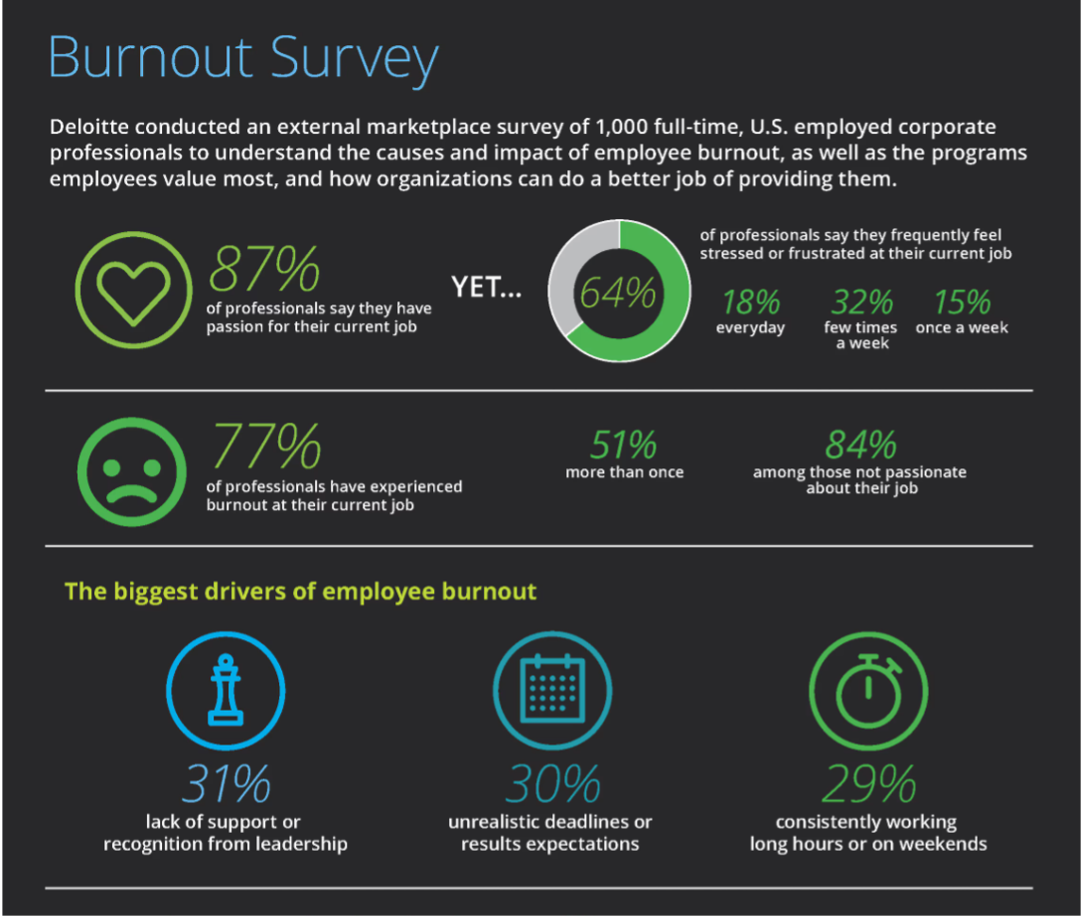Burnout Is a word tossed around casually, often dismissed as simple fatigue.
But for the World Health Organization (WHO), it’s a serious issue with a clear definition: burnout is a state of “chronic workplace stress that has not been successfully managed.”
Alarmingly, FlexJobs reports that 75% of workers have experienced burnout…
And the consequences?
Unproductive employees, high absenteeism, and a revolving door of talent.
As a leader, fostering a culture that addresses burnout isn’t just about employee well-being, it’s about the success of your entire team.
Workplace burnout symptoms:
Watch for feelings of exhaustion, negativity towards work, and a decline in productivity. These signs can manifest in a variety of ways, from missed deadlines to increased cynicism and withdrawal from colleagues.
- The American Psychological Association (APA) highlights “essential workers” – those in healthcare, service sectors, and education – as particularly vulnerable.
- Left unchecked, burnout leads to a vicious cycle: unhappy employees disengage, productivity plummets, and team morale suffers.
- According to Gallup, burned-out employees are 63% more likely to take a sick day and 2.6 times as likely to be actively seeking a different job.
Burnout is not about doing too much, it’s often about giving too much without having our fuel tanks refilled with appreciation or acknowledgment that our efforts are making a difference
Understanding the root causes of burnout empowers you to address them directly.
Here are the 5 main issues that lead to
those workplace burnout symptoms:
1. Excessive Workload and Overwhelm:
Imagine constantly feeling like you’re drowning in tasks.
A study by Gitnux found that “60% of US workers indicated that the pressures and responsibilities of the workplace and home life don’t have boundaries.” The rise of remote work adds another layer – the inability to “unplug” after hours further blurs the lines and fuels burnout.
2. Lack of Control and Autonomy:
Feeling like a cog in the machine is a recipe for disengagement.
Deloitte’s survey revealed that a lack of support and resources is a major driver of burnout, with 77% of respondents experiencing it at their current job. Micromanagement and a rigid work environment stifle creativity and leave employees feeling powerless.
3. Lack of Recognition and Reward:
Everyone wants to feel valued. The BMC Public Health report identifies “under-challenged burnout” – a state where workers feel dissatisfied due to a lack of acknowledgment or growth opportunities.
When hard work goes unrecognized, motivation wanes and burnout sets in.
4. Unfair Treatment and Toxicity:
A toxic work environment breeds misery.
The same BMC Public Health report describes “worn-out burnout” – disengagement caused by poor management or a sense that contributions are undervalued.
Favoritism, unclear communication, and a lack of psychological safety or support from managers all contribute to a stressful and demotivating workplace.
5. Work-Related Stress:
Chronic stress is a burnout accelerant.
Gallup’s State of the Global Workplace report found an alarming 44% of respondents experienced high stress levels – the highest ever recorded.
Excessive deadlines, unrealistic expectations, and an unsupportive environment all contribute to a pressure cooker that leads to burnout.
The good news? You can combat burnout as a leader!
WORKPLACE BURNOUT SOLUTIONS FOR YOUR TEAM
Now that you understand the issues and symptoms of workplace burnout, here are the five factors you can focus on to cultivate a environment where people can thrive…
The 5 things that foster mental health, happiness, and skyrocketed productivity are:
– Resources
– Relationships
– Recognition
– Realistic workloads
– Rest
-
Invest in Helpful Team Resources:
We all know Maslow’s Hierarchy of Needs, right? Well, guess what? Your team members can’t achieve their full potential if their basic needs aren’t met. This doesn’t just mean a decent paycheck (though that’s important, too!).
Think about the tools, technology, and training they need to do their jobs effectively.
Are they constantly struggling with outdated software that slows them down? Do they lack the skills necessary to tackle new challenges? Investing in resources demonstrates that you value their work and want them to succeed.
Equip your team with the tools and support they need to succeed. This includes clear communication, training opportunities, and access to technology.
Empowered employees are less likely to feel overwhelmed and burned out.
-
Cultivate Meaningful Relationships:
Humans are social creatures who crave connection. A workplace devoid of strong relationships is a recipe for isolation and, you guessed it, burnout. As a leader, it’s your responsibility to foster a sense of community within your team. Encourage collaboration, celebrate successes together, and create opportunities for informal interaction.
But don’t just focus on surface-level relationships.
Foster a culture of collaboration and connection. Encourage team building activities and open communication channels. When employees feel supported by colleagues and managers, they’re less likely to experience burnout.
Take the time to get to know your team members as individuals. Understand their strengths, weaknesses, and aspirations. When you show genuine interest in their well-being, you create a safe space where they feel comfortable expressing their concerns and asking for help. This kind of supportive environment goes a long way in preventing burnout and fostering a sense of belonging. Strong relationships create a buffer against stress and contribute to a more positive work experience.
-
The Power of Recognition:
Let’s face it, everyone likes to feel appreciated. When your team members go the extra mile, acknowledge their efforts! A simple “thank you” or a public shout-out can make a world of difference. Consider implementing a formal recognition program, but don’t underestimate the power of informal praise as well.
Recognition is crucial because it reinforces positive behaviors and motivates individuals to continue exceeding expectations. When employees feel valued for their contributions, they’re more likely to feel engaged and invested in their work. This sense of purpose is a powerful antidote to burnout.
Celebrate achievements, big and small. Public recognition and genuine praise show employees their contributions are valued.
-
Realistic Workloads for Sustained Success:
Let’s be honest, nobody thrives under constant pressure. One of the biggest contributors to burnout is an unrealistic workload. As a leader, it’s your responsibility to ensure your team has a clear understanding of their responsibilities and that those expectations are achievable. Prioritize tasks, delegate effectively, and be open to adjusting deadlines when necessary.
Don’t fall into the trap of equating busyness with productivity.
Just because someone is working long hours doesn’t mean they’re getting quality work done. Overworked employees are more likely to make mistakes, miss deadlines, and ultimately, experience burnout. Overloaded employees burn out quickly.
Work with your team to set realistic goals and deadlines.
-
Recharge and Refuel: The Importance of Rest
We all know the saying, “You can’t pour from an empty cup.”
Well, the same goes for your employees. Constant work without breaks leads to exhaustion and, yep, you guessed it – burnout. As a leader, it’s crucial to encourage your team to take advantage of paid time off, breaks, and vacations.
But don’t just give them permission to rest – actively promote it!
Discourage the mentality of working through breaks or checking emails on vacation. By setting clear boundaries and leading by example, you create a culture that prioritizes well-being alongside productivity.
Encourage healthy boundaries and discourage working long hours. Promote work-life balance and lead by example. Offer flexible work arrangements and paid time off, and encourage employees to use them.

Implementing these 5 effective strategies – investing in resources, cultivating meaningful relationships, recognizing achievements, managing realistic workloads, and promoting rest – will help you create a work environment that fosters mental health, happiness, and skyrocketing productivity.
Remember, happy employees are not only more engaged and creative, but they’re also less likely to leave your company. Reduced turnover translates to significant cost savings for you.
So, conquer burnout, and watch your team – and your bottom line – thrive!
Team building activities and employee engagement initiatives help to build a supportive environment where people feel valued. Investing in Your Team’s Well-being requires a proactive approach of building strong relationships within your team.
By implementing the strategies outlined above, you can create a workplace culture where employees feel valued, supported, and motivated. Remember, a happy, healthy team is a productive team.
Ready to transform your team’s dynamics and boost productivity?
Let’s make your next professional development day a memorable success. Together, let’s unlock your team’s full potential and foster a culture of excellence
– – – – –
Sean Glaze is a leadership speaker, teambuilding facilitator, and author who delivers engaging experiences that ignite your team’s performance. Sean has worked with clients like Cisco, John Deere, the CDC, and Emory University to increase collaboration, boost productivity, and build more positive and profitable workplace cultures.
ignite your team’s performance. Sean has worked with clients like Cisco, John Deere, the CDC, and Emory University to increase collaboration, boost productivity, and build more positive and profitable workplace cultures.
As a successful basketball coach, Sean gained valuable insights on turning talent into teamwork – and now he travels around the country to share those lessons. Sean’s conference keynotes and custom team building events deliver laugh-out-loud moments and memorable take-aways that transform your people into winning teammates and more effective leaders.
Sean’s books, Rapid Teamwork, The 10 Commandments of Winning Teammates, and Staying Coachable are entertaining parables that help accelerate the growth of leaders and their teams!


